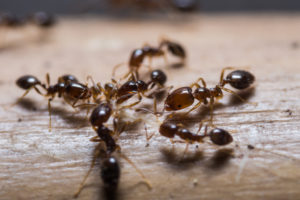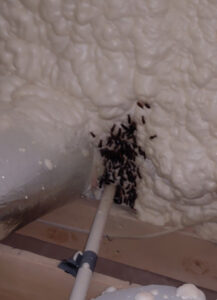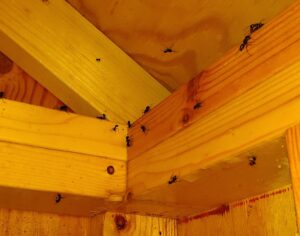Here Come the Ants

Spring has sprung and with the season comes the arrival of ants!
Small ants, big ants, red ants, black ants, the time has come for ant populations to build in number and soar throughout the summer and fall months here in north Georgia.
Now is the best time to make sure you have a dependable and knowledgeable pest control company protecting your home from the coming invasion.
Why are there so many ants in the spring?
Why do we see such a dramatic surge of ant activity in the spring? It is interesting to note that ants are unable to regulate their own body temperature, meaning they are ectothermic. Because of this, wintertime and cold temperatures mean that ants slow down and go into a bit of a dormant state. This doesn’t mean your home might not see any ants in the winter, since they might have moved in seeking shelter before the cold weather started, but spring definitely brings a population surge. As the weather warms up, ants become more active and start back to work foraging for food and building new colonies. Typically spring ants are hungry because they have used up stored foods obtained in the fall. Workers leave the nest and begin the search for food; finding the food prompts a pheromone release, which in turn lets the other colony members know where to find the buffet. If this buffet happens to be your kitchen, well, you’ve got a problem.
You might notice trails of ants in your yard or home, that is the colony following the pheromone trail from the nest to the food source. Homeowners may also notice swarming ants. Often mistaken for termites, the male ants are setting out to create satellite colonies. Spring begins a new cycle of ant colonies which continue to reproduce throughout the late spring and early summer.
What are the ants looking for?
Ants are looking for a water source for their colony as well as food. In the springtime, they are often looking for oil-based foods due to the depletion of winter reserves. Sugar is also a popular food and a draw for foraging ants.
What kind of ants might Cherokee County residents be seeing?
The US is currently home to around 1,000 types of ants, but Georgia has identified about 25 varieties that are regularly known to infest our homes. We will briefly discuss a few of the most common species found in North Georgia.
The Argentine
One of the varieties we see often is the Argentine ant. This small ant averages a size of o

ne-eighth to one-fourth of an inch in length and is a shade of brown ranging from light to extremely dark, often shiny in appearance. Outside habitats include areas beneath stones and boards or near the base of shrubbery. Inside your home, they can become a major problem by nesting in wall voids and in insulation.
Odorous House Ant
Odorous House Ants are also active this time of year and result in many frantic phone calls here at the office. They are tiny, averaging one-sixteenth to one-eighth of an inch, and are brownish-black in color. But here is the big identifier of the odorous ant…they stink if you crush them. Probably not the best way for a homeowner to find out the ant variety sharing their kitchen, but there it is! Outdoors, these ants live in leaf piles, thick grasses, or under stumps and stones. Inside, you will find them in wall voids or near hot water pipes or leaky fixtures. Another thing to know is they will live in wood that has been damaged by termites.
Thief Ant
The Thief Ant is even smaller than the odorous ant, measuring one-thirty-second to one-sixteenth of an inch long. They are brown to yellow in color. Outside, you can find their nests in many places such as under rocks and debris piles, but inside they live in cracks, crevices, and cabinet interiors.
Crazy Ant
The next one is a frustrating species for homeowners because of how difficult it is to find and eliminate nesting areas. The Crazy Ant is about one-eighth of an inch in length and is either a reddish or black/deep blue color, depending on the variety of Crazy Ant. The name came from their crazy, erratic movement pattern. The reason they are difficult to get rid of is because they travel a longer distance than most ants from the nesting site, making it hard to find the originating nesting area.
Pharaoh Ant
Arguably, one of the most difficult to control ant varieties is the Pharaoh Ant. At one-twelfth to one-sixteenth of an inch in length and color ranging from red with black abdomen designs to an almost transparent yellow, this ant is persistent and complicated to control. They make very large colonies, having upwards of several million workers and thousands of producing queens! At this rate, it is hard to eliminate one group before duplicate armies are on the march.
Fire Ant
The fire ant is one who brings fear to every barefoot Georgian who has ever accidentally stepped on one of those infamous dirt mounds! The red imported fire ant is notorious for their vicious attacks and unsightly mounds. The sting of this ant is quite painful for humans or animals and typically results in multiple stings before the victim can escape. Allergies to the venom can mean real danger when it comes to the fire ant. At only one-eighth to one-fourth of an inch in length, their aggression and relentlessness defies their small size. While we most often see fire ants outside in yards and pastures, extreme drought, heat, or even flooding can push the colony to seek indoor shelter in cracks and crevices of structures.
Carpenter Ant
Last but not least is the carpenter ant. These guys build nesting sites inside wood, which make them a real worry for the homeowner. They are well-known to cause damage to structures. As far as size, they are quite large in the ant world at one-fourth to three-fourths of an inch long. They are black or red in coloration and build very quickly so time is definitely of the essence when it comes to stopping the damage of carpenter ants. Outside, these ants  live in dead wood such as stumps or dead branches in trees, although some nest in the soil. Of more significance is the fact that moisture and water damage create conducive conditions for carpenter ants. Wood damaged by moisture attracts carpenter ants and also termites, so it is of the utmost importance to maintain your home’s structural integrity with regular professional inspections from a trustworthy pest control company.
live in dead wood such as stumps or dead branches in trees, although some nest in the soil. Of more significance is the fact that moisture and water damage create conducive conditions for carpenter ants. Wood damaged by moisture attracts carpenter ants and also termites, so it is of the utmost importance to maintain your home’s structural integrity with regular professional inspections from a trustworthy pest control company.
What can I do to prevent an infestation?
As with all pests, prevention is key. Start by sealing all entry points in your home. Cracks and crevices are an open invitation to come on in and make yourself at home, so seal them up. Caulking and weather stripping are easy ways to seal the gaps. Next, make sure all food sources are properly secured, and be sure to clean up any spills promptly. Unsealed containers, crumbs on the counter, trash left in the can, leaking pipes, and water-damaged wood are all major attractions for ants seeking a home. Another preventative measure you can take is to clean up any debris in your yard which might attract ants and also to trim back vegetation in contact with your home. Ants can “bridge” over to your home from plants and trees, making access easier. These are all steps a homeowner can take to help prevent an ant infestation, but there is more you can do to protect your home and family.
The Value of a Professional Pest Control Service
At Canton Termite, we believe that having ongoing pest control service is the ultimate addition to your home’s ant prevention.
Trained, knowledgeable technicians have two secret weapons when it comes to ant treatment: the knowledge to properly identify the problem and the experience to create a targeted treatment program.
First of all, properly identifying the ant in question is vital to preventing or eradicating an infestation. Each ant species has distinctive qualities and habits, making correct identification an absolute must when it comes to effective treatment. A pest professional also understands and can quickly locate conducive conditions which might invite a pest problem. They know where to look and what they are looking for!
Secondly, the experience and knowledge of a pest professional allow for a targeted approach to the treatment plan. This means understanding which ant species prefers sweeter food sources and which prefers higher protein content, allowing a precise approach that maximizes the effectiveness of the treatment. This means less pesticide and more dead ants.
By correctly identifying the species and understanding the proper treatment strategy, Canton Termite is able to work faster and smarter when it comes to helping our customers live pest free.
Knowledge and experience combined with state-of-the-art technology make Canton Termite a leader in the industry. In other words, we know what to look for, where to find it, and how to solve the problem.
If you want to start living pest free, give us a call at 770-479-1598. Put our knowledge and experience to work!
